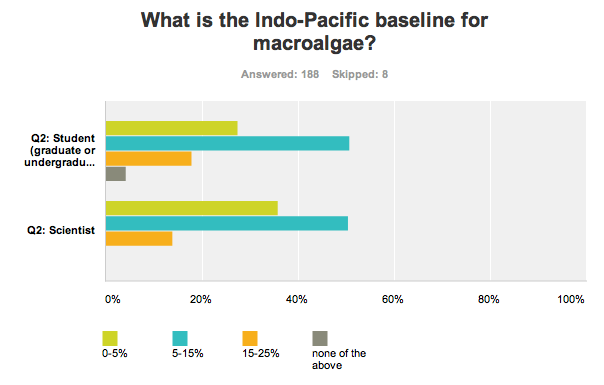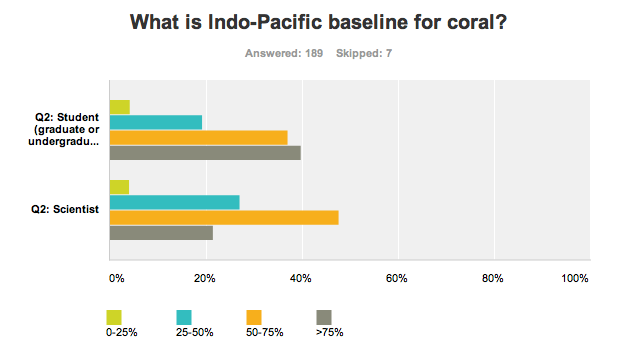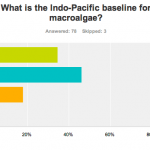“The tragedy of recent coral reef decline is that too few people actually know what coral reefs are supposed to be like, and too few of those who now study reefs witnessed what coral reefs used to be like decades ago.” (Peter Sale and Alina Szmant from the Reef Reminiscences Report)
I am fascinated by baselines – what the natural state of a community was, before people came along and starting mucking everything up. Three colleagues and I recently published a paper about how difficult it is to determine or to estimate baselines (Bruno et al 2013 PeerJ Preprints). We focused on the basline for coral reef macroalgae, but many of the same points would apply to all kinds of habitats. You can get a very different answer depending on the approach you take.
For example, the same has been found for whales and there is a controvery about which method should be used to set the baseline and thus conservation targets and whaling restrictions; molecular genetics, whaling records, fisheries models, etc. One thing we learned during our extended tour of the peer review system (3 years, 6 journals, 9 rejections) was that there is also substantial variability among scientists in what they think is natural. Although nobody seemed comfortable coming out with a clear value, some seemed to support a very low macroalgal baseline of 0-3% (based on their experience in Jamaica in the late 1970s), while others seemed to lean towards 10 to 20 %.
I often find it hard to nail down what my colleagues think about a given issue – in part because we are dispersed around the world with little face-to-face interaction. Venues like the coral-list help fill that void, but like many social forums, it is dominated by a few dozen individuals and many other people are hesitant to share their views on it. To assess the opinions of the coral reef science community (including scientists, managers, students, enthusists, etc) about the baseline values for coral and macroalgal cover on the world’s reefs I set up a SurveyMonkey online survey. I asked four questions:
What is the Caribbean baseline for macroalgae? “Macroalgae” includes fleshy and calcareous species (e.g., Halimeda) but not turf or calcareous encrusting algae. What is Caribbean baseline for coral? “Coral” includes stony, scleractinian corals (not soft corals). What is the Indo-Pacific baseline for macroalgae? What is Indo-Pacific baseline for coral?
I was interested in what people think the regional averages were, noting that even in the past, coral and macroalgal cover varied among reefs due to disturbance dynamics and other natural processes. Therefore, in the pre-human (impact) past, there would be a distribution of state values for coral and macroalgal cover (and other reef characteristics).
What were the mean values for these baseline distributions? These values likely vary among regions, habitats, depths, etc. But what general value (if any) would you give managers as an ideal target for conservation or restoration? Think about what you think “natural” is on shallow (1-15m depth) fore reef environments (not back reefs or reef crests)
Below are the final results of the survey, which was open for five days (mid-day May 21 – mid-day May 26, 2013). (Note the summary data can be downloaded as an excel workbook here from FigShare. Contact me for more information about the survey, for more data, about the results, etc.)
Who took the survey?
 222 respondents took the survey, 129 of which were scientists.
222 respondents took the survey, 129 of which were scientists.
What is the Caribbean baseline for macroalgae?
Most of the respondents thought the Caribbean macroalgal baseline was 5-15% and three times more answered that it was 15-25% than 0-5% .
What is the Indo-Pacific baseline for macroalgae?
The same was true for the Indo-Pacific where the most common choice was 5-15% for the macroalgal baseline, however, the 0-5% answer was much more common; 24% more respondents thought the macroalgal baseline for the Indo-Pacific was 0-5% (69 of 206) than for the Caribbean (19/200). To me, this seems to reflect the existing trends in the Pacific, but not historical data (since there is very little pre-mid-1980s survey data for the Indo-Pacific). Macroalgal cover on the outer GBR was roughly 5% that last time I worked with the AIMS GBR survey data (3 or 4 years ago). Although, there are a lot of very remote and nearly pristine reefs in the central Pacific with substantially higher macroalgal cover (also see this figure from our Baselines PrePrint). Scientists generally answered the same as respondents in the other three categories, e.g., see the summary of answers below from 119 Caribbean scientists compared to the results from all respondents above. E.g., the percentage of scientists that answered 0-5% for the Caribbean macroalgal baseline was 10.1% vs. 9.5% for everyone (including scientists).  Additionally, the answers from scientists and students for all four main questions were very similar, e.g.;
Additionally, the answers from scientists and students for all four main questions were very similar, e.g.; 
 Just for kicks, I compared the answers of 7 of our most experienced colleagues, scientists like Alina Szmant, Rupert Ormond, Charles Birkeland, and Clive Wilkinson, to the other 122 scientists.
Just for kicks, I compared the answers of 7 of our most experienced colleagues, scientists like Alina Szmant, Rupert Ormond, Charles Birkeland, and Clive Wilkinson, to the other 122 scientists.
- Q3: What is the Caribbean baseline for macroalgae? Answers: 5-15%, 5-15%, 5-15%, 5-15%, 5-15%
- Q4: What is Caribbean baseline for coral? Answers: 25-50%, 25-50%, 25-50%, 25-50%, 50-75%
- Q5: What is the Indo-Pacific baseline for macroalgae? Answers: 0-5%, 5-15%, 0-5%, 0-5%, 5-15%
- Q6: What is Indo-Pacific baseline for coral? Answers: 50-75%, 25-50%, 25-50%, 50-75%, 25-50%, 50-75%
Note that like the other respondents, the uber-experienced scientists did not answer every question. All seven answered 5-15% for the Caribbean macroalgae baseline but three of five thought the Indo-Pacific macroalgae baseline was lower (0-5%). At 25-50%, our most experienced colleagues also thought the Caribbean baseline was lower than just over 40% of us (who voted 50-75%). None voted 10-15% or >75% for baseline coral cover in either region. And they were split on the coral baseline for the Indo-Pacific with half answering 25-50% and the other half answering 50-75%.
What is the Indo-Pacific baseline for coral?
The views in our field about what is “natural” in terms of coral cover is somewhat ambiguous. For the Indo-Pacific, although 50-75% was the most common answer (90/207) a sizable number of people answered 25-50% or >75%. The same is true for the Caribbean, where both 25-50% and 50-75% were popular choices. In fact, 79% of us think the Caribbean coral cover baseline is between 25 and 75%! This could be due in part to my choice of answer categories. Perhaps if I had included 40-60% as a choice, our opinions would have appeared less variable.
What is the Caribbean baseline for coral?
I agree with the majority of respondents that baseline coral cover is higher in the Indo-Pacific than in the Caribbean, simply due to the morphology of the dominant coral species – the Caribbean lacks the plating Acroporid corals that can dominate Pacific reefs.
Context, Commentary, and Criticism
I received a fair amount of commentary on and criticism of the survey from colleagues via email. Mainly suggestions for how questions could have been worded, etc.
There are a million ways the questions could have been asked. I kind of regret not asking for specific values instead of supplying a few categorial answers. Then I could have done some cool stats with the results.
Several people wrote to say I should have included a question about age or years diving experience or year of first reef dive. The idea being that more experienced people would have better insight into what is natural. I have mixed feelings about this. On the one hand, the observations of people that were at least working on reefs, and in some cases doing surveys, four or five decades ago are invaluable. But on the other, I think via a number of venues (e.g., Jackson’s Reefs Since Columbus paper and The Reef Reminiscences Report) these observations have been successfully shared with and absorbed by younger generations of reef scientists (including me), so I wasn’t surprised to see little if any differences in answers between scientists and students and only minor differences between less and more experienced scientists.
Furthermore, ideally, what we each think is “natural” is based on more than simply our own experiences: presumably data, published papers, surveys of near pristine reefs, etc all help form our opinions about coral reef baselines. In which case, age or experience really shouldn’t matter all that much, assuming the respondent is familiar with the literature, etc. Additionally, since nobody was diving when humans really began to seriously degrade reefs, it could be argued that observations from the middle part of the last century reflect that period, but not the true baseline.
Regardless, several people wrote to argue the survey was useless since it only collected opinions rather than data. However, the data is presumably incorporated into our opinions. And the data comes from too many sources, using too many approaches, to be combined into a single value. Finally, as Phil Dustin pointed out (below) we have no perfect data, since we have data from so few quantitative surveys, even in the 1970s and early 1980s. That said, given how important it is to establish coral reef baselines, I think we need to do the best we can with the data at hand.
The survey certainly has other weaknesses and limitations. It is a bit preposterous to lump the entire Indo-Pacific region (which contains 75% of the worlds reefs) into a single region. Additionally, since (as we argue here) the natural state of coral reefs certainly varied among sites and regions, asking for a single baseline range could be viewed as foolish.
Below are some of the comments and suggestions I received via email (for which I received permission to reproduce). If you have additional points to make, please do so using the blog comments function (which I have fixed).
:::::::::::::::::::::::::::::::::::::::::::::::::::::::
Dear John,
Makes a difference whether they are measured by transects or towboard, transects will produce higher coral cover numbers since people pick better than average spots for transects. Most of the data until recently is surely transect data, so I made my estimates based on transects, except for Pacific macroalgae, the only wide survey I know reporting macroalgae is the Vroom paper based on the US Pacific towboarding.
Doug Fenner, PO Box 7390, Pago Pago, American Samoa 96799 USA
—————-
I hope this message finds you well. In the process of completing this survey, I think this is an over-simplification of the macroalgae-coral cover story. In the Florida Keys, for example, the baseline, if you want to call it that, for patch reef macroalgae might be on the order of 5-10%; on shallow spur and groove reefs, especially before the demise of elkhorn coral, it might be less than that, with > 80% coral cover by one species. However, there are huge areas of the deeper fore-reef that have had 40-70% for a long time (like before 1985). In addition, and I know that south Florida is an outlier because of its northerly location, but there are HUGE seasonal differences in macroalgal abundance.
In addition, the final question (#7) fails to mention disease as an ultimate cause of coral loss. Of course, there are many factors that might cause disease, which is a physiological stress response, but the loss of acroporids in the Caribbean from WBD alone caused much of the change, no? Has WBD been linked to any of the ultimate causes in question #7. Isn’t it also possible that weedy species, especially the acroporids, ultimately suffered from an over-crowding effect? For example, see Shinn (1963), where there is geological evidence from Molasses Reef (which Gene and colleagues dynamited apart) that A. palmata died back several centuries ago after thousands of years of prolific growth.
Anyway, we have lots of macroalgae and coral cover data for south Florida, it’s intimately tied to habitat type and depth, and thus it certainly makes a difference where one looks. In addition, I think we are also leaving out another story, which is algal turf. Once that stuff takes over the substratum and starts to trap sediment, basically it is game over for corals. We also have a lot of data going back to the late 1990s/early 2000s on interactions between macroalgae and corals. Might be worth us collectively taking a closer look.
Cheers,
Mark Chiappone, Research Scientist Nova Southeastern University – Oceanographic Center
—————-
I enjoyed the idea of the survey! and I think it is a “nice” perspective for a coral reef ecologist. When I filled it, I thought about some problems…but being a “beta” 🙂 attempt, I thought it was not worth mentioning. One was the possibility of someone just filling it “for the fun of it” (which may be solve at some extent adding your name), and the other was the absence of an answer for not knowing/not having an opinion. For example, a person can be rather knowledgeable about the Pacific and not having the opportunity to visit/study the Caribbean or vice versa. I know it would be difficult to encompass all the possible exceptions in the survey (eg Eastern Pacific vs Indo-Pacific….), and I am sure you are aware of its limitations 🙂
Cheers
Carolina Bastidas, Depto de Biologia de Organismos Universidad Simon Bolivar
—————-
Dear John, A neat idea. I have completed your survey. But could I make a couple of further comments. I fear your coral cover categories may be too broad to detect much. In the Red Sea and Indian Ocean where I mostly work general mean upper fore reef cover has to my mind – in general – declined from around 40-45% to 25-30%. Thus both my historic and current mean values come within your 25-50% range.
I know 40-45% seems low, since some reef areas have much higher coral cover, even >90%, but equally cover in the reef edge area is often <25%. In rapid reef assessment by zones I use (in addition to others) categories of 25-40, 40-60, and 60-75%, where 40-60 appears as “about half”. These three categories can I think be distinguished reliably, but this is about as far as an experienced observer can go without days of transect work.
The other comment is that it would have been great to ask (to the nearest 5 years) how long your respondent had been diving / doing research. I find that young researchers are increasingly unfamiliar with what I regard as a normal / pristine reef, as I used to see everywhere when I began 50 years ago!!
Rupert Ormond, Corresponding Secretary, International Society for Reef Studies. Hon. Professor, Centre for Marine Biodiversity & Biotechnology, Heriot-Watt University, Edinburgh.
————–
I was going to take your survey, but in the end I decided agianst it. For a long time, I’ve held that we’re currently unable to put error bars on what a baseline for reefs is or should be. That is, I think everyone will have an opinion, but I also think the vast majority probably won’t be able to trace that opinion to hard data. My opinion is that reef “health” vital signs are poorly constrained. I think that if most reef scientists were honest, when asked by what metric they can identify a healthy reef, they would use a phrase famously used by US Supreme Court Justice Potter Stewart to describe his threshold test for obscenity: “I know it when I see it.” I am curious to see what the majority opinion is, though.
Cheers, Eric
Eric J. Hochberg, Ph.D. Associate Scientist Bermuda Institute of Ocean Sciences
———–
Hey John,
I’m here in Bali looking at your survey thinking about OJ Simpson and fact vs beliefs. Without real data opinions are just that. So what people think and what we actually know – not much- are two different things. Asking for opinions rather than data creates a false sense of knowledge. Its like the 10% trophic transfer “law” which everyone talks about as truth but in fact its just opinion.
Why are you doing this when it will probably be misused bymanagement to create some set of false goals?
All the best,
Phil
Phillip Dustan PhD, Department of Biology, College of Charleston, SC

Leave a Reply